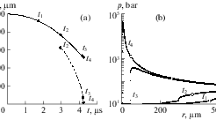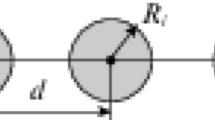Abstract
The influence of the tetradecane temperature \(T_{0}\) and pressure \(p_{0}\) in the ranges from 423 to 663 K and from 15 to 70 bar, respectively, on the formation of radially converging shock waves in a collapsing cavitation bubble is studied. The bubble collapse is spherical, at the beginning of collapse the bubble is filled with tetradecane vapor in the saturation state at temperature \(T_{0}\), the initial bubble radius is 500 \(\mu\)m. The dynamics of the vapor in the bubble and the surrounding liquid is governed by the gas dynamics equations taking into account the non-stationary thermal conductivity of both fluids, the nonequilibrium condensation and evaporation on the interface. A special modification of the known wide-range equations of state by Nigmatulin and Bolotnova, suitable for not very high temperatures of the liquid, is applied. It is shown that at any liquid temperature \(T_{0}\) in the range considered, the bubble content is compressed with the formation of radially converging shock (at \(p_{0}\) in the range 15–70 bar) and isentropic (at \(p_{0}\) in the subrange 15–20 bar) waves. The extreme temperatures and pressures of the vapor in the bubble at the boundary of a ‘‘hot’’ core with a radius of 0.25 \(\mu\)m first increase with decreasing \(T_{0}\) and then decrease. The highest values of those extremes in the rectangle area of the (\(T_{0}\), \(p_{0}\)) plane under study are of the order of \(7\cdot 10^{6}\) bar and \(3\cdot 10^{5}\) K.




Similar content being viewed by others
REFERENCES
K. S. Suslick, ‘‘Sonochemistry,’’ Science (Washington, DC, U. S.) 247, 1439–1445 (1990).
E. M. Galimov, A. M. Kudin, V. N. Skorobogatskii, V. G. Plotnichenko, O. L. Bondarev, B. G. Zarubin, V. V. Strazdovskii, A. S. Aronin, A. V. Fisenko, I. V. Bykov, and A. Yu. Barinov, ‘‘Experimental corroboration of the synthesis of diamond in the cavitation process,’’ Dokl. Phys. 49, 150–153 (2004).
R. P. Taleyarkhan, C. D. West, J. S. Cho, R. T. Lahey, Jr., R. I. Nigmatulin, and R. C. Block, ‘‘Evidence for nuclear emissions during acoustic cavitation,’’ Science (Washington, DC, U. S.) 295, 1868–1873 (2002).
N. S. Khabeev, ‘‘The question of the uniform-pressure condition in bubble dynamics,’’ Fluid Dyn. 45, 208–210 (2010).
S. J. Shaw and P. D. M. Spelt, ‘‘Shock emission from collapsing gas bubbles,’’ J. Fluid Mech. 646, 363–373 (2010).
W. C. Moss, D. B. Clarke, and D. A. Young, ‘‘Calculated pulse widths and spectra of a single sonoluminescing bubble,’’ Science (Washington, DC, U. S.) 276, 1398–1401 (1997).
R. I. Nigmatulin, I. Sh. Akhatov, A. S. Topolnikov, R. Kh. Bolotnova, N. K. Vakhitova, R. T. Lahey, Jr., and R. P. Taleyarkhan, ‘‘The theory of supercompression of vapor bubbles and nano-scale thermonuclear fusion,’’ Phys. Fluid 17, 107106 (2005).
A. Bass, S. J. Ruuth, C. Camara, B. Merriman, and S. Putterman, ‘‘Molecular dynamics of extreme mass segregation in a rapidly collapsing bubble,’’ Phys. Rev. Lett. 101, 234301 (2008).
R. I. Nigmatulin, A. A. Aganin, D. Yu. Toporkov, and M. A. Ilgamov, ‘‘Formation of converging shock waves in a bubble upon its compression,’’ Dokl. Phys. 59, 431–435 (2014).
R. I. Nigmatulin, A. A. Aganin, and D. Yu. Toporkov, ‘‘Possibility of cavitation bubble supercompression in tetradecane,’’ Dokl. Phys. 63, 348–352 (2018).
R. I. Nigmatulin, A. A. Aganin, M. A. Ilgamov, and D. Yu. Toporkov, ‘‘Extreme focusing of energy during shock compression of the vapor bubble in hydrocarbon liquids,’’ High Temp. 57, 228–235 (2019).
R. I. Nigmatulin, A. A. Aganin, and D. Yu. Toporkov, ‘‘Dependence of vapor bubble collapse in hot tetradecane on its pressure,’’ Thermophys. Aeromech. 26, 879–887 (2019).
R. I. Nigmatulin and R. Kh. Bolotnova, ‘‘Simplified wide-range equations of state for benzene and tetradecane,’’ High Temp. 55, 199–208 (2017).
R. I. Nigmatulin and D. Yu. Toporkov, ‘‘Modification of equations of state in the metastable region for high-speed vapor compression,’’ Lobachevskii J. Math. 41, 1278–1282 (2020).
R. I. Nigmatulin, Dynamics of Multiphase Media (Hemisphere, New York, 1991).
Funding
This work was supported by the Russian Science Foundation, project no. 21-11-00100.
Author information
Authors and Affiliations
Corresponding author
Additional information
(Submitted by D. A. Gubaidullin)
Rights and permissions
About this article
Cite this article
Toporkov, D.Y. Influence of the Tetradecane Temperature and Pressure on the Formation of Radially Converging Shock Waves Inside a Collapsing Cavitation Bubble. Lobachevskii J Math 43, 1207–1212 (2022). https://doi.org/10.1134/S1995080222080340
Received:
Revised:
Accepted:
Published:
Issue Date:
DOI: https://doi.org/10.1134/S1995080222080340




